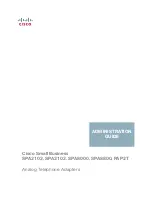
CHAPTER 6
NDA-24305
Page 188
Revision 1.0
CCIS TANDEM CALL-CALLING PARTY NUMBER (CPN) DELIVERY TO ISDN & Q-SIG NETWORKS
C-164
CCIS TANDEM CALL-CALLING PARTY NUMBER (CPN) DELIVERY TO ISDN & Q-SIG
NETWORKS
1. General Description
This feature is provided for the call from tie line (CCIS line or Q-SIG) or a station, attendant console for
INDIVIDUAL ATTENDANT ACCESS [I-6] is sent to the public ISDN network (AT&T, NT, NI-2) or Q-SIG
network since Series 7400 software. With this feature, the calling party number can be changed as programmed
and sent to the ISDN network/Q-SIG network. Since the data can be set to designate the received number in
addition to the outgoing route to ISDN network, a variety of calling party number assignment is available.
2. Operating Procedure
No manual operation is required.
3. Service Conditions
1.
This feature programmed by ACPNCL/ACPNCN command is effective when:
•
Calls are originated from CCIS/Q-SIG line to AT&T, NT, NI-2 or Q-SIG network.
•
Calls are originated from the station to AT&T, NT, NI-2 or Q-SIG network.
•
Calls are originated from the attendant console which is assigned the individual attendant identification
number to AT & T, NT, NI-2 or Q-SIG network.
2.
This feature is not effective when calls are originated from AT&T, NT, NI-2 network to AT&T, NT, NI-2
network.
3.
When the registered calling party number is received from CCIS line and sent to AT&T, NT, NI-2 network
by this feature, the access code and the office code, programmed as ACC for RT=0 (self-office) in ARNP,
are not deleted automatically as normal operation (take this into consideration when programming. See the
example data in
).
4.
ACNP/ACND or AANDE command data are ineffective when the call corresponding to ACPNCL/
ACPNCN command data is originated to AT&T, NT, NI-2 or Q-SIG network.
5.
If number of digits of registered number (RCPN in ACPNCL/ACPNCN data) is less than that of calling
party number sent from CCIS/Q-SIG line, this feature is effective when the first part of the received calling
party number is identical with the registered number.
6.
When assigning more than eight digits’ (includes the office code of the self office programmed in ARNP,
RT=0) number to be received from CCIS line, the number (RCPN in ACPNCL/ACPNCN data) must be
assigned as Physical Station Number since Physical Station Number is sent as the calling party number.
7.
After the system is upgraded from non-fusion system to fusion system, Physical Station Number and
Telephone Number written in LDM that are programmed in ACPNCL command should be deleted and
assign the new Telephone Number using ACPNCN command unless those numbers are identical with
Telephone Numbers to be written in NDM. If the numbers are not deleted, the system gets the wrong number
data or does not get any number data since the fusion system reads out the NDM data.
8.
The fusion system reads out the ACPNCN data. However, if there is no data in ACPNCN, the system reads
the ACPNCL data. The non-fusion system reads out the ACPNCL data only.
9.
This feature is not available for the call originated using OAI/ACD feature.
Summary of Contents for NEAX 2400 IPX
Page 1: ...OCTOBER 2000 NEC America Inc NDA 24305 ISSUE 1 STOCK 200813 ISDN Feature Programming Manual...
Page 2: ......
Page 4: ......
Page 10: ......
Page 16: ...LIST OF FIGURES NDA 24305 Page vi Revision 1 0 This page is for your notes...
Page 18: ...LIST OF TABLES NDA 24305 Page viii Revision 1 0 This page is for your notes...
Page 20: ...CHAPTER 1 NDA 24305 Page 2 Revision 1 0 This page is for your notes...
Page 24: ...CHAPTER 2 NDA 24305 Page 6 Revision 1 0 This page is for your notes...
Page 178: ...CHAPTER 5 NDA 24305 Page 160 Revision 1 0 This page is for your notes...
Page 316: ...CHAPTER 6 NDA 24305 Page 298 Revision 1 0 This page is for your notes...



































